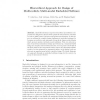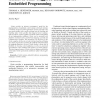EMSOFT
2001
Springer
14 years 4 months ago
2001
Springer
Abstract. We present a framework to extend the concept of type systems in programming languages to capture the dynamic interaction in component-based design, such as the communicat...
EMSOFT
2001
Springer
14 years 4 months ago
2001
Springer
ltiple Levels of Abstractions in Embedded Software Design Jerry R. Burch1, Roberto Passerone1, and Alberto L. Sangiovanni-Vincentelli2 1 Cadence Berkeley Laboratories, Berkeley CA ...
EMSOFT
2001
Springer
14 years 4 months ago
2001
Springer
Abstract. Embedded systems composed of hardware and software components are designed to interact with a physical environment in real-time in order to fulfill control objectives an...
EMSOFT
2001
Springer
14 years 4 months ago
2001
Springer
Abstract This paper is sort of a confession. Issues of synchrony, asynchrony, and synchronization, arise frequently in designing embedded systems from components, like everyone I k...
EMSOFT
2001
Springer
14 years 4 months ago
2001
Springer
: Run-time executives and operating system kernels for embedded systems have long relied exclusively on static priority scheduling of tasks to ensure timing constraints and other c...
EMSOFT
2001
Springer
14 years 4 months ago
2001
Springer
Abstract. This paper presents our experience implementing the memory management extensions in the Real-Time Specification for Java. These extensions are designed to given real-tim...
EMSOFT
2001
Springer
14 years 4 months ago
2001
Springer
rovides an abstract programmer’s model for the implementation of embedded control systems with hard real-time constraints. A typical control application consists of periodic soft...
EMSOFT
2001
Springer
14 years 4 months ago
2001
Springer
EMSOFT
2001
Springer
14 years 4 months ago
2001
Springer
The ability to incorporate low-power, wireless communication into embedded devices gives rise to a new genre of embedded software that is distributed, dynamic, and adaptive. This p...
EMSOFT
2001
Springer
14 years 4 months ago
2001
Springer
Abstract. We classify component-based models of computation into component models and interface models. A component model speci es for each component how the component behaves in a...



